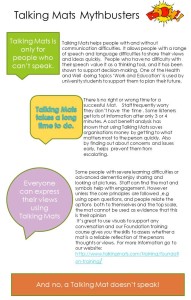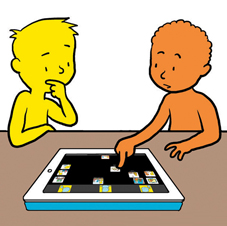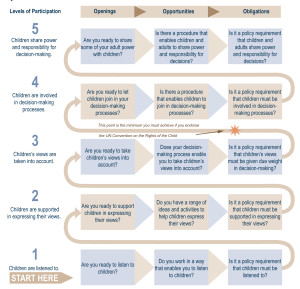Do you need training to use Talking Mats ?
Talking Mats is an effective but deceptively simple tool so a question we are often asked is do you need training to use it. Communication and supporting people with communication difficulties is a complex process and Talking Mats is based on a number of research projects which examined who could use Talking Mats, and how best to use it in different situations. It is therefore important that the integrity of the Talking Mats model is maintained and that Talking Mats training teaches the principles developed from our evidence base.
All our trainers are registered with Talking Mats and provide high quality training based on robust research findings. Only trainers accredited by Talking Mats are eligible to train others.
Some of these principles include:
- Understanding who can and who cannot benefit from using Talking Mats
- Asking open questions
- Handing over control
- Pacing
- Maintaining neutrality
- Interpreting additional information including both non-verbal and verbal information
- Matching the top scale to the question or view being explored
- Presenting the options in an order that maximises the individuals ability to respond by using our model which focuses on concrete to abstract symbols
- Monitoring language complexity and topic sensitivity
All our training courses include hands-on practice and video examples as well as reflection on all these aspects of using Talking Mats
The techniques used in Talking Mats accord with best practice guidance in semi –structured interview techniques including:
- being clear in what you want to find out and using open questions
- enabling elaboration in whatever form is appropriate
- planning in advance but in a context that is flexible and can respond to the dynamics of the conversation
- being cognisant of the influence of the environment
- taking time to establish engagement and rapport
- being non-judgemental
- supportive of periods of silence
- ensuring there is a summary at the end so that both parties agree on what was said .
So whilst Talking Mats may seem simple, it is not simplistic. The listener is creating a space that enables the thinker to think and express themselves. Training gives the listener time to reflect on the components of an effective Talking Mats conversation and identify which ones they are already skilled in and which ones they need to develop further. There are no short cuts to reflective practice training and we know Talking Mats foundation training has impact. Time and time again people who thought they knew about Talking Mats reflect and say things like ‘I got so much more from this training than I expected’ or ‘ I now see I can use Talking Mats for so many different conversations not just ’ I like’ , ‘I don’t like’ ‘or ‘I have been using Talking Mats but now feel much more confident to use it and to make my own submats’

This is why we put so much emphasis on training. We have developed our successful “Train the trainer” scheme to ensure that quality is maintained and reflective practice maintained. If Talking Mats is passed by word of mouth then key aspects of the framework are missed and/or misinterpreted which in turn lessens its effectiveness and impact.
People who come on training are often excited, want to tell colleagues and share it with others. Demonstration and sharing is fine, but it is important to be aware of the difference between sharing and training.
Sharing can often be appropriate especially when there is a team of people supporting the person or parents are keen to see how it works. You can show someone how to use a Talking Mat about a specific conversation. We call this a ‘demonstrating model’. It is helpful to give the listener the words to say to go with it. That way you are enabling other colleagues or family members to have an effective but specific conversation only.
If they then want to use it for other conversations we would strongly recommend they go on to attend the training. Attending a foundation course will enable them:
- to get more out of the technique
- to understand more about their own communication
- to become creative in their use of Talking Mats whilst still adhering to the research principles
- to be able to create their own mats or explore a topic in more depth using submats
So do you need training to use Talking Mats ? The answer is a resounding yes . Training supports you to be an effective Talking Mats listener and get the most out of this versatile communication framework. So if you have not attended a course check out our course opportunities.
https://www.talkingmats.com/training/foundation/
There are a few myths around about Talking Mats. What does it do? – It supports communication and it doesn’t replace a person’s existing modes of communication, be that speech, signing, a symbol book, a voice output communication device or app. Talking Mats works alongside these modes to help people communicate even more effectively about a particular topic.
Some more myths busted! Click on the picture to make it clearer.
Talking Mats is at its heart a Person Centred approach and makes this abstract concept real for practitioners and accessible to more people.
The skills we teach in our training are core to its values:
- Being explicit about the purpose of the conversation
- Using open questions
- Affirmation
- Active Listening
- Personalising
- Summarising
- Clarification
- Acknowledging that this is the persons view today and it is likely to change with time
‘ To improve the lives of people with communication difficulties by increasing their capacity to communicate effectively about the things that matter to them’
Our vision statement matches what is quoted in the introduction of the new Core Skills framework ‘Person-Centred Approaches’ produced by NHS Health Education England, Skills for Health and Skills for Care http://www.skillsforhealth.org.uk/news/latest-news/item/576-new-framework-to-promote-person-centred-approaches-in-healthcare
Talking Mats foundation training gives practitioners a tool to turn the values expressed in this powerful document into practice Read how one health authority made this a priority http ://www.talkingmats.com/person-centred-approach-to-health-planning
To support your organisation evidence they are using a Person Centred Approach look at our website www.talkingmats.com or contact info@talkingmats.com
Talking Mats and Autism- Have you sometimes tried it and it didn’t work?
There is a growing interest in teaching TM to people with ASD. We know that some important adaptations might be required to make this a meaningful experience, and are keen to share our learning so far.
Being asked for thoughts or views can be difficult for some people with communication difficulties. In particular, there is a group of people with autism where some of the core principles of Talking Mats have to be taught in stages. Some thinkers will just ‘get it’ and find it a valuable tool for sharing their thoughts and for supporting decision making. For others there may have to be adaptations and /or specific teaching e.g. the vocabulary of the top scale. We heard recently of a student in a specialist centre who couldn’t use Talking Mats. However the staff would include him in groups where it was used and make sure he was around others doing Mats. After a few years, he did learn the principles and go on to use it effectively.
We have gathered ideas and knowledge from practitioners working in the field of autism and included these on our web-site under Free Stuff on Communication Disability. ASD guidelines It’s important that these guidelines grow and adapt as we learn more about using TM with an even wider range of people.
We’ve arranged a twilight session here at Stirling on the 1st of February 2018 to bring together practitioners working in the field of autism to extend our knowledge and encourage a staged approach to effective use of Talking Mats.
We’re delighted that Ruth Chalmers, Principal Teacher for Autism Spectrum Info and Support Team (ASIST) in Fife will be joining us to talk about developing social communication skills using Talking Mats. There will be time for small group chat so bring along a case you want to discuss.
Please share the attached flier 201802 AsD seminar with your network and we hope you can join us
Please come along and If you are interested in attending this twilight session 4.00pm to 6.00 pm (cost £20.00), please notify us at info@talkingmats.com
Thanks to Natalie Leader, one of our Accredited Trainers from Hobart, Australia for this blog reflecting on her experience of doing the online Foundation training.
The beauty of online training is that no matter where you are or what time zone you’re in, there are options. This is really brought to bear when living in a rural or remote area, such as here in Southern Tasmania.No matter how much those of us here in beautiful Tassie brag about what an awesome place it is to visit, there are limits as to which training organisations will provide professional development sessions here, and how often.
I missed an opportunity to attend Talking Mats Foundation training by a few months so registered to do the online training instead.
My experience with the Talking Mats online training platform was that the organisers were responsive and positive, and the content offered variety, with steady monitoring of progress. Amongst the easy navigation and helpful resources you also participate in discussion forums. As one who doesn’t often participate on line, I found them encouraging and helpful, It was also interesting to read people’s descriptions of different ways that Talking Mats can be used.
Doing the modules in sequence (and with some time in between) worked well for me, as I reflected more deeply on the role of the listener and the qualities I needed to foster in my practice, such as observation, pacing and neutrality.Fostering those qualities and being guided by principles such as self-determination is now an ongoing goal for me.
I have now introduced Talking Mats into my practice and have taken the next step of becoming an Accredited Trainer.
Becoming an accredited trainer involved attending a 2-day workshop in Melbourne for face-to-face training and assessment from Lois and Nicki from Talking Mats Ltd, Stirling, Scotland. As if having excellent trainers was not enough, there was the added bonus of a roomful of like-minded practitioners, all sharing their skills and experiences with Talking Mats. Because each person’s work setting was unique, our group had a rich and diverse array of perspectives on implementation of Talking Mats training and techniques.
So, now I’m making preparations for delivering my first training workshop, sharing Talking Mats with my colleagues. I actually don’t have the jitters (except regarding the IT!) And, I’m confident that Talking Mats will speak for itself. Perhaps I may have appeased the IT deities by taking a giant leap from my former self and participating in a blog, so that side of things will run smoothly!
Good luck with the training Natalie!
This month we have online course participants from Singapore, Canada, Ireland and the UK. Register now for our next online training starting on the 5th of September.
Many thanks to Nicola Lewis from London who has sent us this powerful blog. She has 2 roles – one as a Registered Intermediary with adults with learning disabilities and the other as a family mediator working with children.
I started work as an intermediary, assisting vulnerable people to communicate their evidence to the police and in court. I work with adults with a mild to moderate learning disabilities or mental health issues and with children. The Talking Mats tool has proved invaluable, initially as a rapport building exercise which enables me to build a connection with the person. At the same time I can assess their communication in an informal way. I notice that it is often a relief for those who don’t want to talk as they can just engage in moving the pictures around, without having to make eye contact or without having to speak.They do often start chatting, in spite of themselves as there are not many people who don’t like to talk about their likes, dislikes and preferences and to be heard about what is important to them. I use active listening: reflecting back what they say, summarising, reframing and a touch of humour if appropriate to build a connection, using the mat. When they see me the next time, they often remember me in connection with the Talking Mat:”oh yeah, we did that picture thing!”
I also work as a family mediator and have a specialist qualification enabling me to meet with the children of the family to discuss their wishes and feelings. Again, the Talking Mats tool is the first thing out of my bag and on the table. After working through likes and dislikes in a natural and informal way, I can then use the cards with the children and ask about “your family”, “where you live” etc to find out about how they are managing in a divorce situation and what they might want their parents to know about their feelings. Many mediators will only meet with older children. The Talking Mats tool has given me access to the thoughts of those as young as 5. They are at ease with me and there is a level of trust that did not exist when they entered the room.I have had 100% positive feedback from these meetings as a result.
Thanks for developing this amazing tool. It is incredibly useful to me in both my roles.
Please send us any other stories you would like to share
It is important that we ask people with learning disability about their lives and enable them to raise any concerns. Over the past couple of years we have been developing a Talking Mat called Keeping Safe. It is a resource that gives people time to think about various aspects of their lives, and express how it is going for them.
234 staff in different parts of Scotland now have the resource and have been trained to use it. Feedback includes that using the Keeping Safe resource can improve the quality of communication for both the person with a learning disability and the staff member in the following ways :
- Staff frequently commented that using the Mats revealed things they had not known previously;
‘It gave so much information which we did not expect. It will assist in Adult Support and Protection feedback. It gave him his own say in things.’
‘allowed needs to be identified that I would not have thought to ask about, such as the smoking and taking drugs.’
- It enabled staff have a conversation about more sensitive and or difficult issues;
‘Usually when she expresses her feelings she can get either upset or angry. She did not get upset or angry at any point through doing the Talking Mats, although the subject and things she was saying was at times difficult issues.’
‘A has good communication skills but as we had a sensitive issue (personal care) to discuss I felt that a talking mat would allow us to explore this.’
- It also helped the thinker ( the thinker is the person doing the mat ) to express their thoughts clearly
‘allowed this person to disclose things that they were struggling to disclose verbally.’
- It helped with memory difficulties and kept the thinker focused on the topic
‘It helps with memory and attention as she has something visual to keep her focused.’
- The information gained reflected the thinker’s view and not the views of those around them
‘This resource gave this gentleman the power to say exactly what he was thinking and not what he thought someone wanted to hear.’
- There was a lot of positive feedback on using the resource from people with learning disabilities
‘I adore this. The mats really helped me speak about my feelings.’
- It was a quick way to get information. Initially many staff thought using the resource would take too much time but in fact were surprised to find how much information they got in a short space of time.
The stories gathered from using the resource are powerful and a final report is being prepared which will be launched at a seminar on the 19th May during learning disability week . There are still some spaces on the seminar so if you would like to attend please contact info@talkingmats.com .
We are delighted that the Scottish Government is funding a further round of Keeping Safe Talking Mats training. If you work with adults with learning disability in Scotland, and would like to apply to a Keeping Safe Talking Mats training course then please email us for dates and the application form.
Talking Mats was used as part of a Speech and Language therapy assessment for a boy with a stammer (dysfluent speech). He was very aware of his stammering and would change what he was going to say or avoid some situations because he anticipated that he would stammer. He had low self-esteem about his speech and felt that whenever anyone laughed in his class, it was to do with his stammer.
Talking Mats was used to gather information about which situations and people made speaking easier, and any situations and particular people which caused more of a challenge. The activity provided much more information than originally anticipated.
A starter mat was used to show how a Talking Mat worked, using pictures of food. He engaged well with this, and understood the process quickly. We then moved onto discussing his speech – we wrote names of people in his life and situations which involved speaking onto pieces of paper, and he placed these on the mat where he felt appropriate. We started with people and situations which appeared more positive, then gradually moved onto those it was anticipated would be more challenging.
His insight into his speech and what helped him or made speaking more difficult was impressive. We were able to use this information to compile a list of “Do’s and Don’t’s” for people he came into regular contact with. He agreed that this information could be shared with school to give them strategies to support him there.
The most powerful part of the Mat was him being able to say that he did not feel happy about talking with his big brother sometimes, because he could make fun of his speech, and this made him feel really upset. This was a powerful revelation for his Mum who had sat in on the session, as she had not realised he felt this way. After the session, the family had a chat around the table at tea-time about how his therapy session had gone that day – with Mum’s support he was able to say to his brother about how his teasing had made him feel. His older brother had thought it was all a bit of fun and hadn’t realised the impact it was having. They agreed the older brother wouldn’t tease him anymore.
When he came back for his next session, he commented on being much happier about his talking at home, and felt the activity had been really helpful. His Mum was very positive about it too, and proud of how he had managed to speak up for himself and be able to say how other people could help him with his talking.
Our thanks to Kirsten Taylor, Speech and Language therapist for sharing this powerful story
We are delighted that Nick Stewart, Director, Software and Products with Arum Systems, the IT Consultancy who have built the Digital Talking Mats has chosen TM as his favourite project for a case study.
Here is an extract from his case study describing the Challenge and Process of working with Talking Mats.
The Challenge
The challenge was taking the existing physical Talking Mats tool and building a digital application suitable for multiple platforms, while maintaining the core ethos of the tool. A significant amount of academic research went into creating the physical product and those principles had to be present in a digital version. The applications had to be extremely intuitive to use and enable better conversations for people with communication difficulties.
The aim was to create 3 digital versions; a browser based version for laptop users and a tablet version for iPad users and Android users. Each application would connect to a cloud server, allowing users to log in from any device, and the tablet versions would allow offline working through syncing with the cloud when a connection was available. There was a requirement to set up a multi-tiered subscription based user account system to match the intended charging model for the digital app.
Our Process
Arum’s approach was to totally immerse ourselves in the Talking Mats business to understand their goals, ethos and objectives. We took time to learn how the Talking Mats ecosystem worked and how they wanted to engage with their customers. By applying our 3D Methodology we were able to break down the deliverables into phases allowing the key building blocks to be delivered first. This also allowed the best use of budget and reduced the time to market the new product.
To read the full case study click here Arum Talking Mats Case Study
We are grateful to Emma Atkiss, one of our accredited trainers for this interesting report.
The purpose of The Voice of the Child pilot project carried out by the Wigan Pathfinder team was to obtain pupil views using a viable tool. The team selected Talking Mats as a framework to support pupils to express their views in decisions regarding their lives. They were working on the principle that engaging with the young person and his/her family would lead to better outcomes
The project team considered that Talking Mats met the 5 criteria of Shier’s model of participation (2001)
- Children are listened to.
- Children are supported in expressing their views.
- Children’s views are taken into account.
- Children are involved in the decision-making processes.
- Children share power and responsibility for decision-making.
Click on diagram to enlarge.
The pupils in the pilot ranged from 7 to 17 years with a range of disabilities. During the pupil interviews the team found that the Talking Mats Health and Well being resource provided a practical framework for decision making and target setting
Talking mats provided :
- An objective, neutral space – a thinking tool- ‘Children and young people are able to consider their priorities when setting targets’.
- Opportunities for change – ‘Children and young people are able to make changes to their initial thoughts and have time to decide and reconsider options’.
- A truly person centred approach
- It was fun!
For example : A seven year old child with Autistic Spectrum Disorder identified both her cognitive strengths and areas for development using the Learning and Thinking domain. She provided feedback regarding her difficulty in attending when faced with too much information or choice and also her strength in planning skills. Thinking skills targets and interventions can be developed using this information as a starting point.
Their report states that the information gained from Talking Mats can be used, as part of the Education Health and Care planning and review cycle, to inform both decision-making and goal setting for children and young people i.e. It identifies strengths; It identifies areas to develop; It identifies the child / young person’s response to a range of experiences; It informs day-to-day decision-making ; It informs both targets and interventions for Individual Education Plans and it supports transition planning.
Ref : Engaging the voice of the child / young person at an individual level – Emma Atkiss,Senior Educational Psychologist and Caroline Gomez, Educational Psychologist, Wigan council
 Online training login
Online training login 







